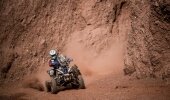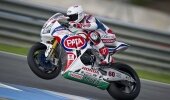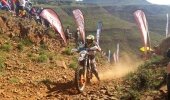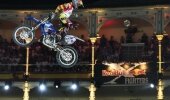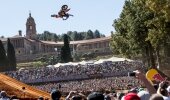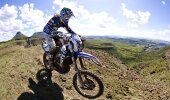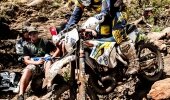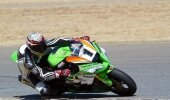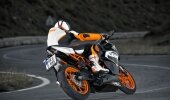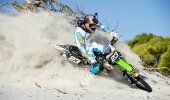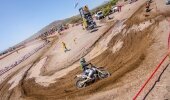Team Rhide SA
South Africa’s Team Rhide SA, who made their debut in the quad category of the 2015 Dakar Rally, claimed exceptional results with Hannes Saaijman winning the First Timers Class and finishing in the top ten (quads) while he was also the only South African competitor to win a stage!
Webventure
The team consisted of two of South Africa’s most experienced off-road quad champions, Brian Baragwanath and Hannes Saaijman, who tackled the Dakar Rally as Team Rhide SA, a name that was derived from the word ‘rhino’ as the team competed to create awareness for the plight of the rhino. At the Dakar Rally, the team had to deal with an early disappointment when Baragwanath experienced engine problems during the first day (Saaijman towed him for 620 kilometres to the overnight bivouac) and had to call it a day during the second stage with two flat rear tyres that later disintegrated.
Saaijman (32), who broke his right hand 10 days before the start of the Dakar Rally, soldiered on despite also experiencing numerous flat tyres (he carried a spare wheel on his quad) and other mechanical problems caused by the long hours of racing and riding under extremely tough conditions. The Pretoria businessman reached his goal to finish the Dakar Rally and completed more than 9 000 kilometres during the two weeks with his Yamaha Raptor 700.
He finished ninth in the quad category (45 quads started the race and 18 made it to the finish) while he won the First Timers Class. He was also the only South African competitor (a total of 10 South African competitors started the Dakar Rally on January 4th in the quads, motorcycle, car and truck categories) to win a stage when he claimed the stage victory in the quad category on the final day in extremely muddy conditions.
Due to the amount of time the pair lost on the first day, Saaijman and Baragwanath started the second day at the back of the field of quads – the motorcycle and quad competitors started together which means that more than a 150 riders were ahead of them. Saaijman aimed to start more towards the front of the field and gradually worked his way up to be just outside the top ten at the halfway mark of the race.
“The Dakar is not a race,” Saaijman said afterwards. “It is survival! The terrain is extremely rough and the dust is very, very bad,” he said at the halfway mark in Chile. “It is not like any race we know in South Africa and you have to approach it differently. That is what I decided to do after starting the race a bit too fast and making mistakes,” he explained.
The team entered the Dakar Rally with the aim to finish the race and win it. They admitted that although they were quite well prepared for a ‘rookie’ team attending this huge race for the first time and doing so with an extremely limited budget, they still learnt a lot.
Looking back Saaijman remember a few days he describes as ‘some of the worst days in my life’. These few days were in Bolivia where it was extremely cold and he did not have enough warm clothing. It also rained heavily while they were on their way to the start of the stage and the rivers were in flood. While some competitors wanted the organisers to cancel the stage due to the rain and flooding, he was determined to push through. “I paid a lot of money to do the race and was not going to give up,” he said. He explained how he looked for a safe place to cross the flooded river and found a train bridge to continue on the route. Afterwards he discovered that many riders suffered from hypotermia because of these extreme weather conditions.
Luckily the altitude (they climbed to almost 5 000m above sea level when racing in the Andes Mountains) did not affect him although it did affect his Yamaha as the engine lost some of its power.
Riders will remember the first of the two *Marathon stages (Stage 8 in Bolivia) as the stage where the world’s largest salt flat, the Salar de Uyuni, took its toll on numerous quads and bikes including the South African motorcycle rider, Riaan van Niekerk who was 12th overall at that stage. The pan was under water due to the heavy rains and the salt damaged the electronics and other parts on the bikes and quads.
Saaijman will remember this day as he lost more than three hours before he could even start the stage due to a faulty ignition solenoid. This meant that he had to play mechanic while it was bitterly cold before he could even start racing. He then picked up penalties (time added to his final result) when he missed two waypoints (certain points riders had to pass) as he decided to rather get to the overnight bivouac before sunset than getting stuck in the dunes after dark.
After racing for 12 days (the race was on for 13 days, but one day was a Rest Day) Saaijman, who claimed a podium result at Stage 11 by finishing the stage in combined third place, has moved up to the ninth place in the quad category and it was time for the last day’s stage in Argentina. It proved to be a highlight of his ‘Dakar’ when he posted the fastest time of the quads to become the only South African competitor to win a stage during the 2015 Dakar Rally.
He has also won the First Timers Class for quad competitors who tackled the race for the first time.
Team Rhide SA has made a name for themselves at their first ‘Dakar’ and will return to South Africa on Wednesday with a class victory and a stage win as well as a top ten result in the bag.
Follow Team Rhide SA’S progress on Facebook (Team Rhide SA) and Twitter (@TeamrhideSA) / teamrhidesa.com
